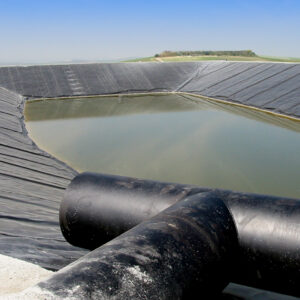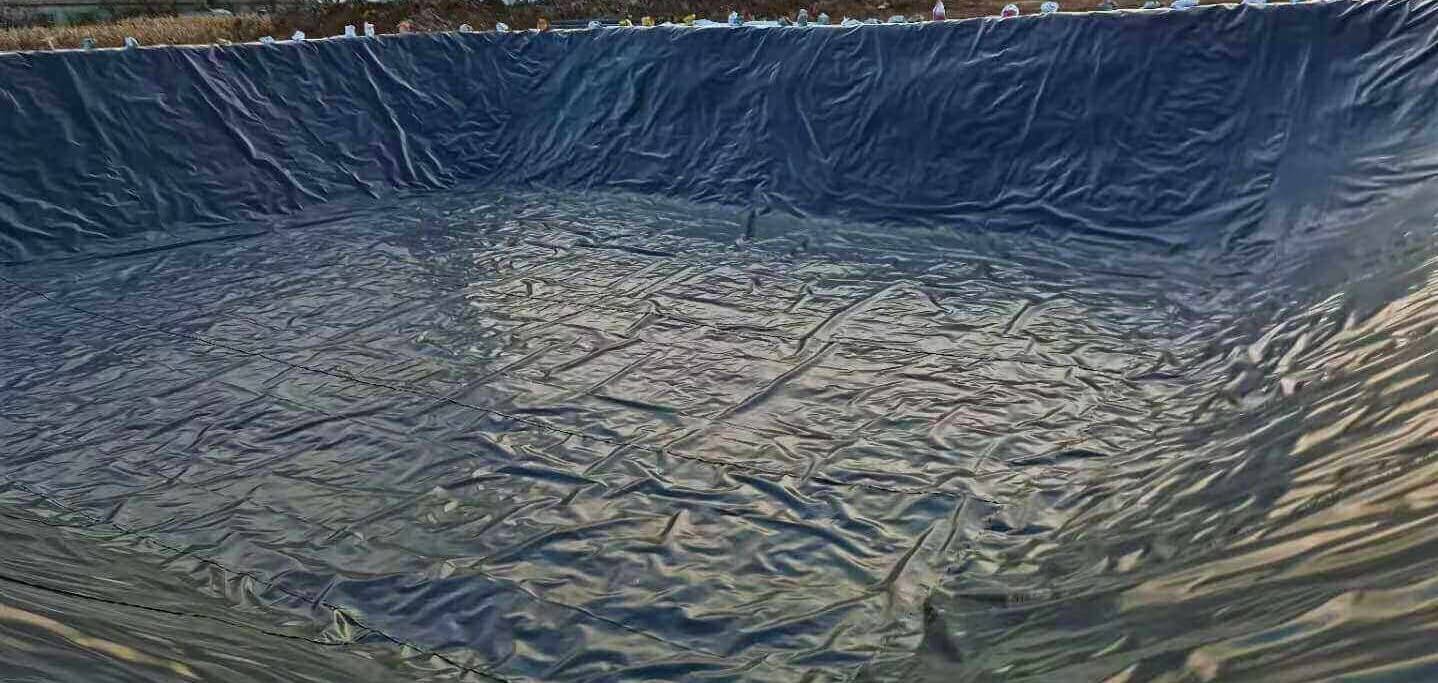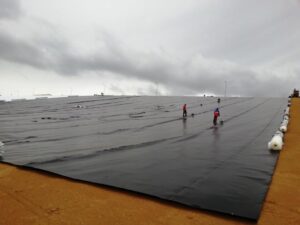What is a geomembrane?
Geomembrane is a synthetic material used in the fields of civil engineering and environmental engineering. It is also called geomembrane, anti-seepage membrane or mulch film.
It is usually a film or thin layer made of plastic materials such as high-density polyethylene (HDPE), low-density polyethylene (LDPE), polypropylene (PP), etc.
The main function of geomembrane is to control moisture, prevent the penetration of water, gas or chemical substances in various engineering projects, and to strengthen soil, protect the environment and other purposes.

What are the uses of geomembrane?
Geomembrane is a membrane material made of polymer materials with certain mechanical strength and anti-seepage properties. It is mainly used in the fields of civil engineering and environmental engineering. It has the following main uses:
Waterproofing projects: Geomembranes are widely used in various water conservancy projects, such as dams, reservoirs, channels, tunnels, etc., to prevent water penetration and protect engineering structures from water erosion.
Landfill: Geomembrane is used as an anti-seepage layer in landfills to prevent liquids in waste from seeping into the soil and groundwater, thereby reducing environmental pollution.
Sewage treatment: In sewage treatment plants, geomembranes are used to build wastewater pools, sedimentation tanks and other facilities to prevent sewage from leaking into the soil and groundwater.
Road and railway projects: Geomembranes are used as reinforcement layers in roadbed projects to improve the bearing capacity and stability of the soil and reduce roadbed settlement.
Land Fill: Used in land fill projects to prevent the fill material from mixing with the surrounding soil, thus reducing infiltration problems.
Environmental protection: Geomembranes can be used to reduce soil and water pollution, prevent harmful substances from penetrating into groundwater or soil, and play an important role in environmental restoration and pollution control.
River, embankment and tidal flat engineering: used to maintain the stability of rivers, embankments and tidal flats to resist erosion and water erosion.
Ecological engineering: In wetland restoration, ecological restoration and land protection projects, geomembranes are used to control soil moisture and maintain the health of ecosystems.
Garden and landscape design: used to control soil moisture, soil separation and vegetation protection, playing an important role in garden and landscape design.
Mining: Used as an anti-seepage layer in garbage dumps and slag ponds in mining projects to prevent harmful substances from seeping into the soil and groundwater.
In general, geomembranes play a key role in civil engineering and environmental engineering, helping to solve problems in water resources management, land use and environmental protection.
Different types of geomembranes will have different characteristics and specifications depending on the requirements and environmental conditions of the specific application.

How to install geomembrane for waterproofing project?
The installation of geomembrane is a very critical step in waterproofing projects. Correct installation can ensure that the engineering structure is protected from moisture erosion. The following are general geomembrane installation steps:
Preparation:
Surface treatment: Make sure the foundation surface is flat, clean, dry, and free of sharp objects, gravel, etc.
Material inspection: Check the quality, specifications, and quantity of the geomembrane to ensure that it meets the engineering requirements.
Equipment preparation: Prepare necessary installation equipment, such as excavators, bulldozers, road rollers, etc.
installation steps:
Foundation treatment: Treat the foundation surface to be flat, and you can use excavation and filling methods to ensure the uniformity of the foundation.
Laying the geomembrane: Lay the geomembrane on the foundation according to the design requirements to avoid wrinkles and bubbles. Usually, the edges where the geomembrane is laid need to leave enough overlap to allow for joint processing.
Seam treatment: Perform hot melt or chemical bonding treatment on the seam parts to ensure that the seams are firm and leak-free. When working with seams, follow the instructions provided by the manufacturer and use appropriate tools and equipment.
Fixed geomembrane: After the geomembrane is laid, special fixing equipment is used to fix the geomembrane to the foundation to prevent wind or other external forces from moving the geomembrane.
Covering protective layer: Covering the geomembrane with a protective layer, usually using sand or special slope protection materials, to prevent direct sunlight and mechanical wear.
Inspection and repair: After laying, conduct careful inspection to ensure that the geomembrane is not damaged and the joints are firm. If problems are found, fix them promptly.
Compaction and backfilling: After the geomembrane is laid, compaction is performed to ensure that the soil under the geomembrane is evenly dense. Backfilling work is then carried out to backfill the excavated earth onto the surface where the geomembrane is laid.
Drainage design: Design a drainage system on the geomembrane to ensure that water can be quickly drained and to prevent moisture from accumulating under the geomembrane.
Monitoring and maintenance: During the use of the project, regularly monitor the status of the geomembrane to ensure its integrity and performance, and perform maintenance and repairs when necessary.
The above steps are general geomembrane installation processes. Specific installation steps and requirements should be carried out according to the specific design of the project and the recommendations of the geomembrane manufacturer. During the installation process, relevant standards and specifications are followed to ensure construction quality and project durability. The installation of geomembrane is a very critical step in waterproofing projects. Correct installation can ensure that the engineering structure is protected from moisture erosion. The following are general geomembrane installation steps:
Preparation:
Surface treatment: Make sure the foundation surface is flat, clean, dry, and free of sharp objects, gravel, etc.
Material inspection: Check the quality, specifications, and quantity of the geomembrane to ensure that it meets the engineering requirements.
Equipment preparation: Prepare necessary installation equipment, such as excavators, bulldozers, road rollers, etc.
installation steps:
Foundation treatment: Treat the foundation surface to be flat, and you can use excavation and filling methods to ensure the uniformity of the foundation.
Laying the geomembrane: Lay the geomembrane on the foundation according to the design requirements to avoid wrinkles and bubbles. Usually, the edges where the geomembrane is laid need to leave enough overlap to allow for joint processing.
Seam treatment: Perform hot melt or chemical bonding treatment on the seam parts to ensure that the seams are firm and leak-free. When working with seams, follow the instructions provided by the manufacturer and use appropriate tools and equipment.
Fixed geomembrane: After the geomembrane is laid, special fixing equipment is used to fix the geomembrane to the foundation to prevent wind or other external forces from moving the geomembrane.
Covering protective layer: Covering the geomembrane with a protective layer, usually using sand or special slope protection materials, to prevent direct sunlight and mechanical wear.
Inspection and repair: After laying, conduct careful inspection to ensure that the geomembrane is not damaged and the joints are firm. If problems are found, fix them promptly.
Compaction and backfilling: After the geomembrane is laid, compaction is performed to ensure that the soil under the geomembrane is evenly dense. Backfilling work is then carried out to backfill the excavated earth onto the surface where the geomembrane is laid.
Drainage design: Design a drainage system on the geomembrane to ensure that water can be quickly drained and to prevent moisture from accumulating under the geomembrane.
Monitoring and maintenance: During the use of the project, regularly monitor the status of the geomembrane to ensure its integrity and performance, and perform maintenance and repairs when necessary.
The above steps are general geomembrane installation processes. Specific installation steps and requirements should be carried out according to the specific design of the project and the recommendations of the geomembrane manufacturer.
During the installation process, relevant standards and specifications are followed to ensure construction quality and project durability.
Author

Founded in 2002, Tinhy's team focuses on the manufacturing, marketing, installation, application and research and development of geosynthetic materials.
View all posts






